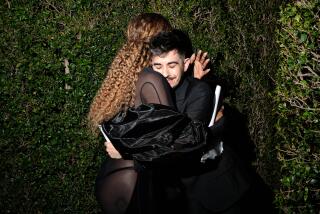Ginetta Sagan Dies; Torture Victim Fought for Political Prisoners
- Share via
Ginetta Sagan, the “Topolino” or “Little Mouse” who was imprisoned, raped and tortured by Italian fascists during World War II but survived to help build Amnesty International, establish the organization on the West Coast and battle the abuse of political prisoners around the world, has died. She was 75.
Sagan, who received the Presidential Medal of Freedom in 1994, died Friday at her home in Atherton, Calif., of cancer, Amnesty International officials said.
“Ginetta Sagan’s name is synonymous with the fight for human rights around the world,” President Clinton said when he presented her the medal in Washington, D.C. “She represents to all the triumph of the human spirit over tyranny.”
Born in Milan to a Jewish mother and Catholic father who were both physicians and anti-fascists as Benito Mussolini came to power, Sagan began working for the northern Italian Resistance as a teenager.
Never taller than 5 feet and with the spirit and energy of a hummingbird, Sagan was quickly dubbed “Topolino.” As a clerk in Milan City Hall, she first supplied food and clothing coupons to help Jews in hiding, and then became a courier for the Resistance, helping some 300 Jews to flee to safety in Switzerland. During her clandestine work, her parents were seized, her father shot and her mother sent to Auschwitz, where she perished.
Betrayed by an infiltrator, Sagan was captured in 1945 by Mussolini’s Black Brigade, and imprisoned, raped and tortured for 45 days. At one point, a loaf of bread was thrown into her cell. When she tore it apart she found a matchbox containing a tiny slip of paper with a single word scrawled on it: couraggio, Italian for “courage.”
“My greatest fear, greater even than the fear of death, which seemed almost a certainty,” she said in an article published in The Times in 1996, “was that I would betray my comrades to the Black Brigade. But to all the torturers’ questions I had managed to answer, ‘I don’t know, I don’t know,’ even after the Black Brigade ‘nurse’ injected me with Sodium Pentothal.”
Another surprise occurred one night when Sagan was being interrogated and beaten at a boarded-up villa in Sondria, Italy. Two German soldiers badgered her Italian fascist guards into releasing Sagan to them for their own questioning. They put her into a waiting car and sped toward what she assumed would be her execution.
“It was a beautiful night with a lot of stars,” she recalled. “I thought, I shall never see another aurora (Italian for ‘dawn’).”
The “Germans,” who turned out to be Nazi defectors working with the Resistance, delivered her to a hospital run by Catholic nuns. She was free and safe.
After the skeletal young woman recuperated, she moved to Paris with her godfather and studied at the Sorbonne. She came to the United States in 1951, and in Chicago met and married a young medical student, San Francisco-born Leonard A. Sagan.
As his career began, the couple lived for a time in Washington, D.C., where Sagan taught cooking classes for congressional wives.
Intensely interested in human rights, she helped establish the fledgling organization Amnesty International. By 1968, when the Sagans moved permanently to Atherton, Amnesty had only 18 chapters with 700 members--all in the Eastern U.S.
Sagan, a homemaker and mother of three sons, formed the 19th chapter of Amnesty USA in her Atherton living room. She went on to become the organization’s first national board member from the West and one of its most active and honored leaders.
In 1971, Sagan organized a concert in Berkeley to raise funds for political prisoners in Greece. The concert, featuring her neighbor and friend Joan Baez and Greek entertainer Melina Mercouri, drew 10,000 people--all potential Amnesty members. Then Sagan hit the road, launching a total of 75 new chapters around the West over the next three years. By 1976, she had helped Amnesty International USA grow a hundredfold to 70,000 members.
“I think she has probably organized more people than anyone else in the human rights movement globally,” her Amnesty colleague David Hinckley said in 1995. “She really is the one who got Amnesty International off the ground in this country.”
Inspired by touchstones in her own imprisonment, in 1973 Sagan founded the first newsletter for the national organization and named it Matchbox, for the item that had given her such hope as a prisoner.
She also established her own Atherton-based organization, dubbed Aurora for that long-ago dawn she feared she might never see. Her group works to document human rights abuses and funnel money to families of prisoners of conscience. Sagan and other members, for example, interviewed 800 former prisoners who had been held in Vietnam to detail abuses there, and also worked with human rights activists on similar projects in Chile, the Soviet Union, Poland and other Eastern European countries.
In honor of Sagan’s work internationally on behalf of women and children imprisoned and tortured, Amnesty International honored her in 1994 by establishing the Ginetta Sagan Fund. That fund provides emergency support to organizations and individuals working around the world to halt abuse of women and children by political entities.
In 1996 Italy awarded her its highest accolade, the Grand Ufficiale del Merito Della Repubblica.
Her myriad honors even included an orchid named for her in recognition of her gardening skills.
Leonard Sagan, a medical scientist with the Electric Power Research Institute in Palo Alto and a human rights worker himself, died in 1997.
Ginetta Sagan is survived by three sons, Loring of San Francisco, Pico of Incline Village, Nev., and Duncan of Fremont, Calif., and six grandchildren.
More to Read
Sign up for Essential California
The most important California stories and recommendations in your inbox every morning.
You may occasionally receive promotional content from the Los Angeles Times.













